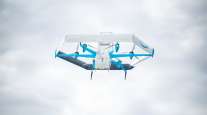Same-Day Delivery Is Limited to Urban Markets, Experts Say
By Rip Watson, Senior Reporter
This story appears in the May 26 print edition of Transport Topics.
New and intensely promoted shipping options such as same-day delivery and package-carrying drones may have some commercial potential, but only in the most densely populated areas, industry experts say.
That was the broad conclusion when Transport Topics asked experts to gauge the future of shipping innovations from Amazon.com and other online retailers.
“The potential for same-day delivery is there in densely populated cities,” BB&T Capital Markets analyst Kevin Sterling told TT on May 21. “As long as delivery companies are compensated for it, they’ll do it.”
Same-day delivery is “a very niche market” for the most urgent shipments with potential that’s limited by economics, said Paula Rosenblum, a retail analyst for RSR Associates.
“There are always two problems for a business,” Rosenblum said. “Is there a market and can we make money at it? You have to have both. In the case of same-day shipping, I don’t think
the consumer is willing to pay much more, so that limits the market for now.”
“The same-day delivery market isn’t quite here yet,” said Ross Merritt, director of marketing and product strategy for Grand Junction, a company that offers delivery software. “It will develop rapidly after Amazon does something meaningful,” he said, estimating that broad use of the approach is two years away.
UPS Inc., FedEx Corp. and Deutsche Post DHL, the world’s three largest package carriers, told TT they already offer same-day options — with limitations to urban areas and special cases.
Kurt Kuehn, chief financial officer at UPS, said last week in a television interview that “we see [next-day] as a much bigger force,” which will be more widely used by retailers than limited same-day options.
Sterling said Amazon.com already is beta testing its own same-day delivery network in San Francisco and Dallas, and that “they have the density to make it work.”
Amazon.com currently does same-day delivery in 12 locations, or about half of the largest metropolitan areas. Regions such as Houston don’t yet have that option.
“I keep hearing same-day shipping is the holy grail,” Sterling said. “But my question is, can you make any money at it, or in the case of Amazon, minimize their losses?”
Amazon.com, which didn’t respond to requests for comment, said in a regulatory filing that its 2013 shipping costs were $3.5 billion more than they charged customers for deliveries.
Its package delivery drone made a publicity splash when CEO Jeff Bezos unveiled it on television the day before so-called Cyber Monday, the busiest online ordering day.
Drones also aren’t new to the three largest package delivery companies, either.
Scott Davis, CEO of UPS, told investors his company has looked at package shipping drones for four years. FedEx has tested drones, too, CEO Frederick Smith told investors.
“I think the technology is not that far away,” Davis said. “I think the regulation is years and years away.”
He was citing the need for the Federal Aviation Administration to create rules for using drones, calling that “an extraordinary challenge.”
DHL in December demonstrated a drone it calls Paketcopter at its headquarters in Germany. CEO Frank Appel later told news outlets that government policy would be a barrier to their commercial use.
Drones also are being showcased to mining and construction industries by companies such as Skycatch. CEO Chris Sanz earlier this year told Bloomberg News that the company is focusing on those industries, rather than package collection.
FedEx Corp. offers SameDay City service, started in 2008, in 21 of the largest metropolitan areas, including New York, Los Angeles and Chicago, spokesman Jess Bunn said.
UPS spokesman Andy McGowan told TT his company offers a same-day critical service option.
Steven Debrabander, global commercial director at DHL, said the company does same-day delivery service for high-value or emergency type shipments such as airline parts.
Their transport options include helicopters, which are used to deliver bank documents in Los Angeles. Offerings are done on a case-by-case basis.
Same-day delivery also has branched out far beyond retail. It’s being used for grocery deliveries by Amazon.com, individual grocers such as Safeway and startup companies such as Instacart.
Merritt also said that grocery and retail same-day delivery are very different markets that will develop separately. Customers still aren’t willing to give up the in-person supermarket visit, he said, though Internet retailing has grown rapidly.
Trucks do both grocery and retail deliveries, though Instacart announced that it had used a horse as a publicity ploy when it entered the Austin, Texas, market this month.
Sterling, Rosenblum and Merritt told TT that the same-day option won’t work outside urban areas because customers are too far apart and delivery times would be too long and too costly elsewhere.
Merritt said established local courier companies are best suited to same-day delivery in the top 25 markets, and possibly more. Those smaller companies with lower costs can do same-day deliveries efficiently because of more flexible schedules.




